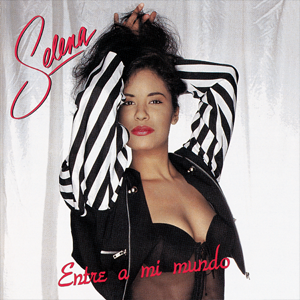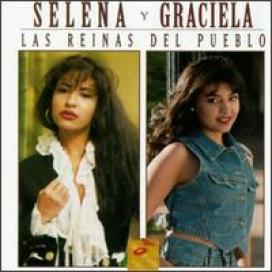
Selena Quintanilla Pérez, known professionally as Selena, was an American singer. Referred to as the "Queen of Tejano Music", her contributions to music and fashion made her one of the most celebrated Mexican-American entertainers of the late 20th century. In 2020, Billboard magazine put her in third place on their list of "Greatest Latino Artists of All Time", based on both Latin albums and Latin songs chart. Media outlets called her the "Tejano Madonna" for her clothing choices. She also ranks among the most influential Latin artists of all time and is credited for catapulting the Tejano genre into the mainstream market.

Amor Prohibido is the fourth studio album by American singer Selena, released on March 22, 1994, by EMI Latin. Having reached a core fan base, the label aimed to broaden her appeal with the next studio release. Finding it challenging to write a follow-up hit after "Como la Flor" (1992), Selena's brother A. B. Quintanilla enlisted the assistance from band members Ricky Vela and Pete Astudillo with writing the album's songs. The resulting album has a more mature sound featuring experimental production that blends diverse musical styles from ranchera to hip-hop music. Amor Prohibido is a Tejano cumbia album modernized with a synthesizer-rich delivery using a minimalist style that was quintessential in early 1990s Tejano music.

Ven Conmigo is the second studio album by American singer Selena, released on November 12, 1990, by EMI Latin. The singer's brother, A.B. Quintanilla III remained her principal record producer and songwriter after her debut album's moderate success. Selena's Los Dinos band composed and arranged seven of the album's ten tracks; local songwriter Johnny Herrera also provided songs for Selena to record. Ven Conmigo contains half cumbias and half rancheras, though the album includes other genres. Its musical compositions are varied and demonstrate an evolving maturity in Selena's basic Tejano sound. The album's structure and track organization were unconventional compared with other Tejano music albums. The songs on Ven Conmigo are mostly love songs or songs following a woman's struggles after many failed relationships.

Entre a Mi Mundo is the third studio album by American singer Selena, released on May 6, 1992, by EMI Latin. The label endeavored to bolster Selena's popularity within the Latin music market in the United States with this release. Selena's brother, A. B. Quintanilla kept his role as the singer's producer and, in collaboration with Selena y Los Dinos members Pete Astudillo and Ricky Vela, composed tracks for the album. The ensuing recording encompassed an eclectic array of songs, attributable to the members' diverse backgrounds, which facilitated the modernization of the many genres they explored. Entre a Mi Mundo is a Tejano cumbia album that encapsulated Selena's quintessential sound, characterized by engaging tunes harmonized with her distinctive, plaintive vocals and a relaxed, danceable cumbia beat. The album incorporates musical inspirations from power pop, R&B, disco, rock, funk, and synthesized Tejano music.

Selena is the self-titled debut studio album by American Tejano singer Selena, released on October 17, 1989, by EMI Latin. Its music incorporates a range of contemporary genres with a mix of cumbia and regional styles of Mexican music. The album was released following company president Jose Behar's failed crossover request for the singer. The project was denied by the heads of EMI Records' pop division, believing the singer should first strengthen her fanbase. Selena's brother and principal record producer and songwriter, A.B. Quintanilla III fought to remain the singer's producer. The band introduced Pete Astudillo and Joe Ojeda, who contributed to the album's experimental production and songwriting. Aside from A.B., Selena worked with two Mexican songwriters, Alejandro Montealegre and Reinaldo Ornelas.

Mis Mejores Canciones – 17 Super Éxitos is a greatest hits album by American singer Selena released on September 17, 1993, through EMI Latin. Beginning in January 1993, the label released a comprehensive collection that spotlighted its Latin music artists as part of its Latin Classics series. Mis Mejores Canciones – 17 Super Exitos encompasses 17 tracks, ranging from songs recorded on her debut album with EMI Latin, to songs present in Entre a Mi Mundo (1992). The album received a positive response from music critics who enjoyed the label's catalog releases and praised the tracks on the album for showcasing Selena's early popular recordings. Following the shooting death of Selena on March 31, 1995, Mis Mejores Canciones – 17 Super Exitos debuted at number one on the US Billboard Top Catalog Albums chart, the first Spanish-language recording to do so. The Recording Industry Association of America (RIAA) certified the album diamond (Latin), denoting 600,000 units shipped in the United States.

Anthology is the first box set by American singer Selena. It was released posthumously on April 7, 1998, through EMI Latin to commemorate the singer's works. The collection comprises 30 tracks, dispersed across three genre-themed discs: "Pop / English" showcases uptempo pop compositions, "Mariachi" highlights Mexican ballads featuring poignant narratives of heartache, and "Cumbia" presents danceable tropical rhythms. The album encompasses recordings from a 14-year-old Selena on her Alpha (1986) album to the posthumous "Disco Medley" (1997). With a limited number of unaltered tracks, Anthology predominantly features reworked and remastered musical arrangements, while preserving the singer's original vocals. Selena's death in March 1995 prompted an influx of requests from her admirers. The singer's father and manager, Abraham Quintanilla, expressed a desire to maintain his daughter's legacy through her music. However, Selena's family has faced criticism from both fans and the media, who accuse them of capitalizing on her death and commodifying her repertoire.

All My Hits: Todos Mis Éxitos Vol. 2 is a greatest hits album by American singer Selena that was released on February 29, 2000, through EMI Latin. After Selena's murder in 1995, her father Abraham Quintanilla stated his commitment to preserving her music and EMI Latin pledged ongoing support for her releases. In 1999, the label's president José Behar acknowledged Selena, who remained the label's top-selling artist, for her contributions to establishing EMI Latin as "the house that Selena built". In March 1999, to commemorate the label's tenth anniversary, it released All My Hits: Todos Mis Éxitos; it achieved commercial success and a sequel was announced. All My Hits: Todos Mis Éxitos Vol. 2 contains 16 songs ranging from tracks featured on Selena's Muñequito de Trapo (1987) to the posthumous 1997 club remix of "Enamorada de Ti" (1990).

Momentos Intimos is a compilation album by American singer Selena and released posthumously on March 23, 2004, through EMI Latin. The album contains 24 tracks, though the last eight are spoken liner notes provided by the singer's family, friends, and her Los Dinos band. The songs on the album range from "Como Te Quiero Yo A Ti" (1988), a re-recorded version modernized and remixed on the album, to "Puede Ser", an unreleased duet with Nando "Guero" Dominguez, recorded two weeks before Selena was shot and killed in March 1995. Following Selena's death, her father Abraham Quintanilla expressed his interest in persevering his daughter's memory through her works. Selena's family has been criticized by fans and the media for exploiting the singer and cannibalizing her murder by commercializing her repertoire.

Pedro Astudillo, known as Pete Astudillo, is an American singer-songwriter, record producer, and dancer. Referred to as "the Latino Babyface" by The Daily Journal, he is regarded as the architect behind Selena's sound, as he collaborated or coauthored the singer's top-selling and most popular recordings that cemented him into music history. Astudillo wrote or collaborated on some of the most popular Tejano music songs of the 1990s and was inducted into the Tejano Roots Hall of Fame in 2019. His impact on the United States Latin music scene lies in his role as a songwriter collaborator, according to Billboard magazine.
Gary Lee Hobbs is an American singer-songwriter, record producer, and actor. Called "Tejano music's Vince Gill", he has been widely recognized for his resonant baritone vocals, characterized by their emotive quality, and is considered a pioneer within the genre. Hobbs played a significant role in the expansion of Tejano music during the 1990s and became one of the most popular Tejano singers of the 1980s and 1990s.

Las Reinas del Pueblo is a compilation album by American Tejano music singer Selena and Mexican banda singer Graciela Beltrán. Posthumously released on April 4, 1995, by EMI Latin in the wake of Selena's death on March 31, 1995, the decision to produce a compilation album featuring Beltrán emerged after her tribute to the singer at a Houston memorial. The title was inspired by Mexican newspapers that referred to Selena as "an artist of the people" during a 1992 press tour in the nation and subsequently dubbed her "La Reina del Pueblo" in the aftermath of her death. Las Reinas del Pueblo encompasses six tracks by Selena and six by Beltrán, encapsulating their respective tenures with EMI Latin. Las Reinas del Pueblo peaked at number four on the US Billboard Top Latin Albums and Regional Mexican Albums chart, both behind other Selena releases. The recording peaked at number 147 on the American Billboard 200 chart. The album peaked at number ten on the Spanish albums chart in 2010. Beltrán's participation in the album yielded substantial promotional and sales enhancements.

"Ámame" is a song by American singer Selena, taken from her third studio album, Entre a Mi Mundo (1992). Selena and Chris Pérez began secretly dating subsequent to Pérez's reintegration into Selena y Los Dinos in the summer of 1991, despite her father's objections. The song was written by Selena and conveys her sentiments towards Pérez as they concealed their liaison from familial scrutiny. Pete Astudillo contributed to the lyrical development of the composition, while A. B. Quintanilla handled production. It was released as the fourth and final single from the album in April 1993.

"¿Qué Creías?" is a song by American singer Selena, taken from her third studio album, Entre a Mi Mundo (1992). It was written by Pete Astudillo and A. B. Quintanilla; the composition was a result of a challenge issued by A. B. to Astudillo to create a song before they arrived in Las Vegas from California. Astudillo drew inspiration from the works of Mexican singer Juan Gabriel, culminating in a mariachi ballad. Selena, in describing the song, avers that it embodies women on a collective scale. It is the singer's torch song and the lyrics elucidate Selena's inflexible stance on refusing to absolve an unfaithful partner. She directly addresses her former lover who had taken her for granted, informing him of her capability to exist without him. Critics acclaimed Selena's emotional vocal range and her poetic expression with a distinctly feminine cadence.

"Como la Flor" is a song recorded by American singer Selena. Written by A. B. Quintanilla and Pete Astudillo, it was released as the second single from her third studio album Entre a Mi Mundo (1992). The song was written by Quintanilla, who was inspired by a family selling illuminated plastic flowers at a concert in Sacramento, California, in 1982. A decade later, Quintanilla was seized with an infectious melody and abruptly dashed out of the shower in a hotel room in Bryan, Texas, to recreate it on a keyboard with Astudillo. He completed the music in just 20 minutes, while Astudillo took another hour to complete the lyrics. "Como la Flor" is an up-tempo, Tejano cumbia torch song that blends tropical cumbia rhythms with hints of reggae and pop music. Its lyrics describe the feelings of a female protagonist addressing her former lover, who abandoned her for another partner. The narrator is uncertain of her ability to love again, while at the same time, wishing her former partner and his new lover the best.

"La Carcacha" is a song recorded by American singer Selena for her third studio album, Entre a Mi Mundo (1992). The song was written by A.B. Quintanilla and Pete Astudillo. It was inspired by a dilapidated car and an experience in which A.B. observed a woman's willingness to court the owner of a luxury car. The song, characterized by its rhythmic melodies and satirical portrayal of life in the barrio, highlights the importance of love and genuine connection over material wealth. It is a Tejano cumbia song that is emblematic of Selena's typical style, while music critics found it to be musically similar to "Baila Esta Cumbia".

Como Te Extraño is the second studio album by American Tejano music singer Pete Astudillo. It was released on November 21, 1995 through EMI Latin. The album was produced by A. B. Quintanilla, who played alongside Astudillo as part of Selena y Los Dinos, a band fronted by Selena. Como Te Extraño was a commercial success peaking at number six on the US Billboard Top Latin Albums chart and number two on the US Billboard Regional Mexican Albums chart. The title track, "Como Te Extraño", was a tribute song for Astudillo's mother and Selena. The title track peaked atop the US Billboard Regional Mexican Songs chart, while the album's second single "Si No Fui Yo" peaked at number 38 on the US Billboard Hot Latin Songs chart. The album also contains "Contigo Quiero Estar", Selena's 1989 debut single with EMI Latin. Como Te Extraño won the Tejano Music Award for Album of the Year - Orchestra at the 1996 Tejano Music Awards.

Freddie Records is an American independent record label founded in Corpus Christi, Texas on November 1, 1969, by musician Freddie Martinez. Originally functioning as a recording studio and distributor for Martinez, the label expanded its roster to include other Tejano musicians to avoid financial failure. The label commenced producing albums for an array of artists, including Ramón Ayala, Agustin Ramirez, Oscar Martinez, and Joe Bravo. Ayala became the best-selling act of the label, sustaining the financial stability of Freddie Records throughout the 1970s and 1980s. The label sponsored a Little Joe concert in 1978 and recorded it for their Live for Schlitz album. It led to a ban on future events in the area, though the album remained a lucrative live recording for Freddie Records for two decades. As Tejano music's popularity surged, Freddie Records augmented its foundation by incorporating an additional 6,000 square feet for a second studio and production facility replete with updated MCI equipment capable of accommodating cassette tape and 8-track formats and instigated a release schedule of two albums per month on average.

Si Tu No Estas is the fourth studio album by American Tejano music singer-songwriter Pete Astudillo. The album peaked at number 37 on the US Billboard Top Latin Albums chart. The title track is a tribute song to Selena, who was shot and killed on March 31, 1995, this is the second tribute song for the singer following "Como Te Extraño" (1995). Astudillo was a backup dancer and singer for her group Selena y Los Dinos. The title track was intended for the 1997 film soundtrack of Selena, but was shelved. "Si Tu No Estas" was nominated for Song of the Year at the 1998 Tejano Music Awards, while "No Le Niego" was nominated for Tejano Crossover Song of the Year.
Isabel Marie Sanchez is an American Tejano music singer. Sanchez gained initial recognition as a child performer in various singing and dancing contests. Her breakthrough occurred on the third season of La Voz Kids, which caught the attention of record executive Abraham Quintanilla. Sanchez released her debut album, New Girl in Town in 2016, and received critical and commercial success. She was awarded the Tejano Music Award for Best New Female Artist, becoming the youngest recipient of the award. Her second album, Sígueme (2017), was nominated for Album of the Year, while her third studio effort, Xoxo - Hugs and Kisses (2018), achieved commercial success. After her fourth album, IV (2019), was released, Sanchez departed Q-Productions, indicating a desire for a new musical direction. Her fifth album, Una Illusion (2022), earned her a nomination for the Latin Grammy Award for Best Tejano Album. Sanchez has been active in charitable and non-profit organizations and was honored by the Texas House of Representatives for her contributions to the arts and community.


















